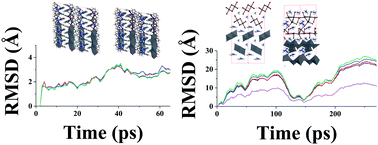Novel design strategies for perovskite materials with improved stability and suitable band gaps†
Abstract
The instability of organometallic halide perovskites is deemed a key hindrance hampering their commercial utilization in solar cell research. In the current work, we investigate and compare the dynamics properties of both free NH4+ and that immobilized in a NH4+–H2O–H2O–H2O–H2O–NH4+ network in a one-dimensional (1D) Pb–I skeleton. The simulations show that both the space occupancy and the hydrogen bonding formation ability of the A-site groups significantly influence the transition of the 1D NH4PbI3 perovskite materials to two-dimensional/three-dimensional (2D/3D) hybrid structures. Based on these observations, two possible pathways enhancing the structural stability of the perovskite materials are proposed. To narrow the big band gap introduced by the quantum confinement effect in the low-dimensional structures, large metal complexes are introduced as A-site groups considering that metal ions are involved in the formation of both conduction and valence bands of the perovskites. In this way, the band gap of the 1D perovskite materials is narrowed and the structural stability is enhanced accordingly. In addition, by optimizing the ratio of NH4+ to CH6N3+ (GUA+) groups, novel 2D/3D hybrid perovskite materials of (NH4)1−x(GUA)xPbI3 with improved stability and narrower band gaps are suggested as well. These structural design ideas hopefully illuminate the development of innovative and stable perovskite materials.



 Please wait while we load your content...
Please wait while we load your content...